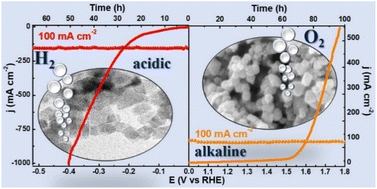Robust and promising hydrogen and oxygen evolution reactions by a nanostructured bifunctional FeCoPd alloy electrocatalyst†
Abstract
Herein, we developed trimetallic FeCoPd polyhedral alloy nanoparticles (NPs) as a new highly efficient and promising bifunctional electrocatalyst for hydrogen and oxygen evolution reactions (HER and OER). The as-synthesized polyhedral NPs possess mainly octahedral and cuboctahedral particles with exposed highly active {100} and less active {111} facets. The partial atmospheric surface oxidation of FeCoPd NPs led to the formation of oxidized metal ion sites for the adsorption of *OH and *OOH reactive species, and the catalyst on a graphite sheet substrate in a 1.0 M KOH electrolyte can afford 10 mA cm−2 current density at 197 mV overpotential in the OER. The surface metal sites of the catalyst act as the active site for the adsorption of Hads reactive species for the HER, exhibiting a 52 mV overpotential at 10 mA cm−2 in 0.5 M H2SO4. The FeCoPd electrocatalyst offered a high current density of 1000 and 550 mA cm−2 in acidic (at −0.40 V, HER) and basic (0.540 V, OER) media, respectively. With a high mass activity of 4.67 A g−1, it also showed long cycling stability over 10 000 cycles and durability for 100 h at high constant current density (100 mA cm−2) without any degradation of the catalyst. It also demonstrated OER stability in 30 wt% KOH with 180 mV overpotential at 10 mA cm−2. Computational studies were further used to understand and validate a proposed mechanism corroborating the experimental results.



 Please wait while we load your content...
Please wait while we load your content...